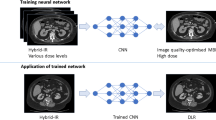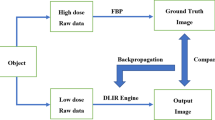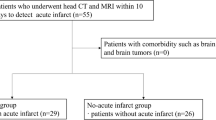Abstract
Purpose
To compare the image quality of brain computed tomography (CT) images reconstructed with deep learning–based image reconstruction (DLIR) and adaptive statistical iterative reconstruction-Veo (ASIR-V).
Methods
Sixty-two patients underwent routine noncontrast brain CT scans and datasets were reconstructed with 30% ASIR-V and DLIR with three selectable reconstruction strength levels (low, medium, high). Objective parameters including CT attenuation, noise, noise reduction rate, artifact index of the posterior cranial fossa, and contrast-to-noise ratio (CNR) were measured at the levels of the centrum semiovale and basal ganglia. Subjective parameters including gray matter-white matter differentiation, sharpness, and overall diagnostic quality were also assessed and compared with the interobserver agreement.
Results
There was a gradual reduction in the image noise and artifact index of the posterior cranial fossa as the strength levels of DLIR increased (all P < 0.001) compared with that of ASIR-V. CNR in both the centrum semiovale and basal ganglia levels also improved from the low to high strength levels of DLIR compared with that of ASIR-V (all P < 0.001). DLIR images with medium and high strength levels demonstrated the best subjective image quality scores among the reconstruction datasets. There was moderate to good interobserver agreement for the subjective image quality assessments with ASIR-V and DLIR.
Conclusion
On routine brain CT scans, optimized protocols with DLIR allowed significant reduction of noise and artifacts with improved subjective image quality compared with ASIR-V.



Similar content being viewed by others
References
Barber PA, Demchuk AM, Zhang J, Buchan AM (2000) Validity and reliability of a quantitative computed tomography score in predicting outcome of hyperacute stroke before thrombolytic therapy. ASPECTS Study Group. Alberta Stroke Programme Early CT Score. Lancet (London, England) 355(9216):1670–1674. https://doi.org/10.1016/s0140-6736(00)02237-6
Hill MD, Demchuk AM, Tomsick TA, Palesch YY, Broderick JP (2006) Using the baseline CT scan to select acute stroke patients for IV-IA therapy. AJNR Am J Neuroradiol 27(8):1612–1616
Heuscher DJ, Vembar M (1999) Reduced partial volume artifacts using spiral computed tomography and an integrating interpolator. Med Phys 26(2):276–286. https://doi.org/10.1118/1.598523
Jones TR, Kaplan RT, Lane B, Atlas SW, Rubin GD (2001) Single- versus multi-detector row CT of the brain: quality assessment. Radiology 219(3):750–755. https://doi.org/10.1148/radiology.219.3.r01jn47750
Pelt DM, Batenburg KJ (2014) Improving filtered backprojection reconstruction by data-dependent filtering. IEEE Trans Image Process 23(11):4750–4762. https://doi.org/10.1109/TIP.2014.2341971
Cho HH, Lee SM, You SK (2020) Pediatric head computed tomography with advanced modeled iterative reconstruction: focus on image quality and reduction of radiation dose. Pediatr Radiol 50(2):242–251. https://doi.org/10.1007/s00247-019-04532-z
Liu X, Chen L, Qi W, Jiang Y, Liu Y, Zhang M, Hong N (2017) Thin-slice brain CT with iterative model reconstruction algorithm for small lacunar lesions detection: image quality and diagnostic accuracy evaluation. Medicine 96(51):e9412. https://doi.org/10.1097/MD.0000000000009412
Hardie AD, Nelson RM, Egbert R, Rieter WJ, Tipnis SV (2015) What is the preferred strength setting of the sinogram-affirmed iterative reconstruction algorithm in abdominal CT imaging? Radiol Phys Technol 8(1):60–63. https://doi.org/10.1007/s12194-014-0288-8
Geyer LL, Schoepf UJ, Meinel FG, Nance JW Jr, Bastarrika G, Leipsic JA, Paul NS, Rengo M, Laghi A, De Cecco CN (2015) State of the art: iterative CT reconstruction techniques. Radiology 276(2):339–357. https://doi.org/10.1148/radiol.2015132766
Chartrand G, Cheng PM, Vorontsov E, Drozdzal M, Turcotte S, Pal CJ, Kadoury S, Tang A (2017) Deep learning: a primer for radiologists. Radiographics 37(7):2113–2131. https://doi.org/10.1148/rg.2017170077
LeCun Y, Bengio Y, Hinton G (2015) Deep learning. Nature 521(7553):436–444. https://doi.org/10.1038/nature14539
Benz DC, Benetos G, Rampidis G, von Felten E, Bakula A, Sustar A, Kudura K, Messerli M, Fuchs TA, Gebhard C, Pazhenkottil AP, Kaufmann PA, Buechel RR (2020) Validation of deep-learning image reconstruction for coronary computed tomography angiography: impact on noise, image quality and diagnostic accuracy. J Cardiovasc Comput Tomogr 14:444–451. https://doi.org/10.1016/j.jcct.2020.01.002
Greffier J, Hamard A, Pereira F, Barrau C, Pasquier H, Beregi JP, Frandon J (2020) Image quality and dose reduction opportunity of deep learning image reconstruction algorithm for CT: a phantom study. Eur Radiol 30:3951–3959. https://doi.org/10.1007/s00330-020-06724-w
Osborn AG, Hedlund GL, Salzman KL (2017) Osborn’s brain. In: Dementias and brain degeneration, 2nd edn. Elsevier, Philadelphia, pp 1072–1074
Pomerantz SR, Kamalian S, Zhang D, Gupta R, Rapalino O, Sahani DV, Lev MH (2013) Virtual monochromatic reconstruction of dual-energy unenhanced head CT at 65-75 keV maximizes image quality compared with conventional polychromatic CT. Radiology 266(1):318–325. https://doi.org/10.1148/radiol.12111604
Riordan AJ, Bennink E, Viergever MA, Velthuis BK, Dankbaar JW, de Jong HW (2013) CT brain perfusion protocol to eliminate the need for selecting a venous output function. AJNR Am J Neuroradiol 34(7):1353–1358. https://doi.org/10.3174/ajnr.A3397
Goldman LW (2007) Principles of CT: radiation dose and image quality. J Nuclear Med Technol 35(4):213–225; quiz 226-218. https://doi.org/10.2967/jnmt.106.037846
Rozeik C, Kotterer O, Preiss J, Schutz M, Dingler W, Deininger HK (1991) Cranial CT artifacts and gantry angulation. J Comput Assist Tomogr 15(3):381–386. https://doi.org/10.1097/00004728-199105000-00007
Kilic K, Erbas G, Guryildirim M, Arac M, Ilgit E, Coskun B (2011) Lowering the dose in head CT using adaptive statistical iterative reconstruction. AJNR Am J Neuroradiol 32(9):1578–1582. https://doi.org/10.3174/ajnr.A2585
Hsieh J, Liu E, Nett B, Tang J, Thibault J-B, Sahney S (2019) A new era of image reconstruction: TrueFidelity™. White Paper (JB68676XX), GE Healthcare
Wu D, Kim K, Li Q (2019) Computationally efficient deep neural network for computed tomography image reconstruction. Med Phys 46(11):4763–4776. https://doi.org/10.1002/mp.13627
Willemink MJ, Noel PB (2019) The evolution of image reconstruction for CT-from filtered back projection to artificial intelligence. Eur Radiol 29(5):2185–2195. https://doi.org/10.1007/s00330-018-5810-7
Akagi M, Nakamura Y, Higaki T, Narita K, Honda Y, Zhou J, Yu Z, Akino N, Awai K (2019) Deep learning reconstruction improves image quality of abdominal ultra-high-resolution CT. Eur Radiol 29(11):6163–6171. https://doi.org/10.1007/s00330-019-06170-3
Awai K, Higaki T, Tatsugami F (2014) Clinically essential requirement for brain CT with iterative reconstruction. Br J Radiol 87(1044):20140474. https://doi.org/10.1259/bjr.20140474
Schaller F, Sedlmair M, Raupach R, Uder M, Lell M (2016) Noise reduction in abdominal computed tomography applying iterative reconstruction (ADMIRE). Acad Radiol 23(10):1230–1238. https://doi.org/10.1016/j.acra.2016.05.016
Khawaja RD, Singh S, Otrakji A, Padole A, Lim R, Nimkin K, Westra S, Kalra MK, Gee MS (2015) Dose reduction in pediatric abdominal CT: use of iterative reconstruction techniques across different CT platforms. Pediatr Radiol 45(7):1046–1055. https://doi.org/10.1007/s00247-014-3235-2
Greffier J, Frandon J, Pereira F, Hamard A, Beregi JP, Larbi A, Omoumi P (2020) Optimization of radiation dose for CT detection of lytic and sclerotic bone lesions: a phantom study. Eur Radiol 30(2):1075–1078. https://doi.org/10.1007/s00330-019-06425-z
Author contribution statement
Injoong Kim participated in material preparation, data collection and analysis, drafting the manuscript, and funding acquisition. Na-Young Shin designed the study and participated in the analysis of data and interpretation, and critical revision of the manuscript for important intellectual content. Hyunkoo Kang participated in study concept and design and critical revision of the manuscript for important intellectual content. Hyun Jung Yoon participated in study concept and design and critical revision of the manuscript for important intellectual content. Bo Mi Chung participated in study concept and design and critical revision of the manuscript for important intellectual content. All authors read and approved the final manuscript.
Funding
This study was supported by a Veterans Health Service Medical Center Research Grant, Republic of Korea (VHSMC 20057).
Author information
Authors and Affiliations
Corresponding author
Ethics declarations
Conflict of interest
The authors declare that they have no conflict of interest.
Ethical approval
All procedures performed in studies involving human participants were in accordance with the ethical standards of the institutional and/or national research committee and with the 1964 Helsinki declaration and its later amendments or comparable ethical standards. For this type of study, formal consent is not required.
Informed consent
For this type of retrospective study, formal consent is not required.
Additional information
Publisher’s note
Springer Nature remains neutral with regard to jurisdictional claims in published maps and institutional affiliations.
Rights and permissions
About this article
Cite this article
Kim, I., Kang, H., Yoon, H.J. et al. Deep learning–based image reconstruction for brain CT: improved image quality compared with adaptive statistical iterative reconstruction-Veo (ASIR-V). Neuroradiology 63, 905–912 (2021). https://doi.org/10.1007/s00234-020-02574-x
Received:
Accepted:
Published:
Issue Date:
DOI: https://doi.org/10.1007/s00234-020-02574-x




